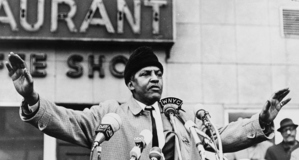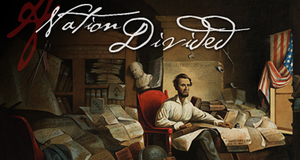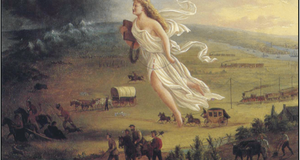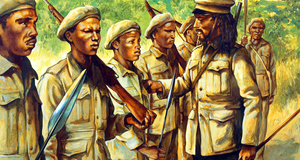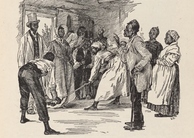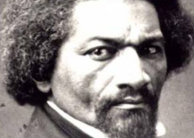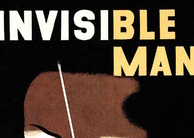Featured Article:The X Factor: How Malcolm X Internationalized the Civil Rights Movement
By
2010, Vol. 2 No. 04 | pg. 1/1
KEYWORDS:
"The reasonable man adapts himself to the conditions that surround him... The unreasonable man adapts surrounding conditions to himself... All progress depends on the unreasonable man." “You don’t do any singing, you’re too busy swinging”i. Thus spoke Malcolm X. He promulgated the new paradigm of anti-nonviolenceii he helped popularize during the 1960s. It had been around a decade since Brown v. Board of Education overturned the “separate but equal” laws; yet, the progress of desegregation had been stagnant. This was especially true for X who, goaded by impatience and indignation, became the symbolic antithesis of Martin Luther King and his nonviolent strategy. He called for “Black Power!” or Black Nationalism, not just as an organizing principle but also as a means by which to overcome a Negro Inferiority Complex inculcated by many decades of practiced racism in the US. This, of course, aroused a wildfire of discomfort—from whites and blacks alike. Responding to X's philosophy, MLK, Roy Wilkins of the NAACPiii, Whitney Young of the Urban League, and white leaders staged a joint denouncement of Black nationalism and separatist sentimentsiv. John Lewis, a leader of Student Nonviolent Coordinating Committee (SNCC)v, also balked at Black nationalism. He even went as far as saying in his autobiography that X “was not part of the [Civil Rights] movement” because he did not share the movement’s “goal of an integrated society, an interracial democracy, a Beloved Community”vi. All told, X provoked a salvo of criticism and was rightly seen by many as a force to be dealt with. Yet, despite his popular condemnation and disrepute, it was him and his bold radicalism that brought forth the shift of the Civil Rights Movement (CRM), and its cause on the world stage.The trajectory of the shift began with X’s call for Pan-Africanism. In November of 1963, before a grass roots conference in Detroit, X declared that the enemy of African Peoples is the “white man” who colonized the continentvii. He spoke of Kenya, Congo, South Africa, Guinea, and Algeria, et al, as once occupied territories of the “white man,” or Europeans viii. Hitherto, no voice of the CRM had invoked a global analogy to explain a parochial problem. By nodding to newly freed African nations, X transcended the conventional and spent borders of rhetoric by which the CRM argued. The CRM typically dressed up their rhetoric with talking points from God, Jesus, and Gandhi—from peaceniks. X’s talk of having a common enemy among African Peoples, therefore, was seen as radical as it was provocative. But despite the finger wagging of many Black Leaders, X’s provocation galvanized the CRM afresh. It became only a matter of time for X’s views to transpire throughout Africa, where they would be well received. By autumn of 1964, X was touring the African and Middle Eastern nations, conferring with state leaders, wielding his nascent influence, and making the US State Department loosen its tie and worry about US global image. Around the same time, Lewis and other members of SNCC were also in the continent. Here’s how Lewis describes X’s popularity in the continent: "[T]he young Africans we met were voraciously curious about all that was happening in the United States. And more than anything else, they wanted to know all about Malcolm X. He became the measuring rod in every one of our encounters. As soon as we were introduced… the first thing he [sic] would ask was, ‘What’s your organization’s relationship with Malcolm’s?’"ix X was popular indeed; but what surprised Lewis was how little the African students and activists knew about SNCC or the Deep South demonstrations or even the CRM in general. “They were the victims of pro-American propaganda,” said Lewisx. In other words, after a decade of protesting and singing and making noise in the US the CRM was yet to be heard Africa. Whereas X’s larynx, in less than year, had become something of a celebrity—which can be ascribed to his urgent prompting for Pan-African unity in his ‘63 Speech. During his African tour, X used the world pulpit to buttress his Pan-African rhetoric. “[Y]ou are the shepherd of all African people,” he told a Cairo audiencexi. “We, in America, are your long-lost brothers and sisters,”xii he said. X emphasized that the passage of Civil Right legislation had done little to ameliorate the domestic problems of African-Americans, and that the public relations work of the US to publicize the Civil Rights legislation was propaganda meant to lead people to believe that the ill conditions of Black Americans were on a healing pathxiii. There’s a lot of truth in this. The US State Department, in tandem with the United States Information Agency, was, at the time, in the business of framing the narrative of the Civil Rights Movement in a way that promoted Americanism, and counteracted Soviet influencexiv. X’s presence in Africa, then, was a big pain in the tush for the US State Deptartment. The State Department reported to Washington of X’s “extreme statements to the press” which set off real concerns among African leaders about the racial problems in the USxv. Meanwhile, X continued to say things like, “[A]s long as you take money from America, you’ll have only the external appearance of sovereignty”xvi xvii. Thus enter civil rights issues on the world forum. Because of X, civil rights issues in the US was appended into the more wide-reaching, morally compelling arguments of anti-imperialism—not what you want if you are the US muscling for influence against Communists. The argument was a subtext in X’s ’63 speech, which, as if deliberately timed, flourished like flowers on the world stage. During their encounter in Africa, X told Lewis that the CRM needed to change their focus “from race to class”xviii which in essence is a Marxist statement. “[T]he great powers [US and Soviet Union]…[are] using poor people…for their own imperialistic ends,” X whispered to Lewisxix. And out loud, X reminded African leaders that it was within their position of power as newly freed nations to denounce the US’s treatment towards its black population. Not long after X’s African tour, SNCC, and the Black Panther Party were linking the Civil Rights Struggles to the Third World Struggles against imperialismxx. X was assassinated in 1965. The baton of anti-imperial rhetoric was passed on to the other two Big M’s: MLK and Muhammad Ali. In 1967, MLK declared his opposition to the Vietnam War, which he attached to the problem of poverty xxi. “I was increasingly compelled to see the war as an enemy of the poor and to attack it as such,” he said, for which he was criticized from all quarters, even from the NAACP. As the 1964 recipient of the Nobel Peace Prize, MLK’s opposition was heard throughout the world. Just the same, Ali’s symbolic refusal to comply with conscription orders to fight in Vietnam that same year was also heard. “I am not going ten thousand miles from here to help murder and kill and burn another poor people simply to help continue the domination of white America,” he said. This was the stuff of world headlines—in London, Paris, Berlin, Zurich, Madrid, Hong Kong, Rome, and Amsterdamxxii. Ali, moreover, received letters of commendation from many world leaders, including Bertrand Russellxxiii xxiv. There is not a doubt that mobilizing the civil rights debate into the world stage was integral to the parochial progress of the CRM. It was the ingenuity of Malcolm X that forged global awareness of the Civil Rights Struggles in the US. He exploited the fact that the US at the time (and perhaps today still) was very image-conscious and was malleable to change things within its borders just to maintain its rank as a world leader. X hamstringed the US’s ability to frame the CRM’s narrative for propagandic use. Even Lewis, who did not agree with Xism, was forced to concede that X brought the movement into a “broader perspective” and “into a worldview, likening the struggle for human rights in Africa and other nations”xxv. X was extreme, but he knew what he was doing. When he returned from African Tour in December of ‘64, he had the following to say: "The greatest accomplishment that was made in the struggle for the black man in America in 1964 toward some kind of progress was the successful linking together of our problem with the African problem, or making our problem a world problem"xxvi. There is reason to believe that X’s radicalism was strategic in that he wanted to dispel the confidence and expectation out of the white extremists that if they attacked a black person, s/he’ll only turn the other cheek. He said: "I think that the people in this part of the world would do well to listen to Dr. Martin Luther King and give him what he’s asking for and give it to him fast, before some other factions come along and to do it another way"xxvii. Lewis was right to call this a threat, but he failed to see that this was method-minded, a gambit to goad the Civil Rights Movement into taking longer and faster strides. On Malcolm X’s funeral, Lewis reports that no one criedxxviii: perhaps that is because few felt he had really died. Endnotesi.) Malcolm X, “Message to the Grass Roots” in The Eyes on the Prize Civil Rights Reader, ed. Clayborne Carson et al, (New York: Penguin, 1991), 254 ii.) The use of “anti-nonviolence” is deliberate on my part, based on my interpretation of Malcolm X’s philosophy/ideology. As oppose to “violence” or “pro-violence,” I think “anti-nonviolence” is more accurate because it is rooted from the notion of self-defense in the same way that violence is “necessary” for Robert F. Williams as a means of self-defense. iii.) National Association for the Advancement of Colored People iv.) Malcolm X, “Message to the Grass Roots,” 246 v.) Student Nonviolent Coordinating Committee vi.) John Lewis and Michael D’Orso, Walking with the Wind: A Memoir of the Movement (San Diego: Harvest Book/Harcourt Brace & Company) 1998. p 204. vii.) Malcolm X, “Message to the Grass Roots,” 250 viii.) Ibid, 250. ix.) Lewis, Walking with the Wind, 286. x.) Ibid, 286. xi.) Dudziak, Mary L., Cold War Civil Rights: Race and the Image of American Democracy (Princeton: Princeton University Press) 2000. p. 220. xii.) Ibid, 220. xiii.) Ibid, 222. xiv.) Ibid, 13. xv.) Ibid, 222. xvi.) Dudziak, Cold War Civil Rights, 222. xvii.) Whether X it knew or not, foreign aid as a means-of-coercion was a prevalent practice of the US, particularly Latin America during the Cold War. Che Guevara and Fidel Castro were also famous for dealing the same accusations against the US. xviii.) Lewis, Walking with the Wind, 278. xix.) Ibid, 288. xx.) Ibid, 226. xxi.) Martin Luther King, Jr., “A Time to Break Silence,” in The Eyes on the Prize Civil Rights Reader, ed. Clayborne Carson et al, (New York: Penguin, 1991), p. 388. xxii.) Carson Clayborne, “The Time Has Come” in The Eyes on the Prize Civil Rights Reader, ed. Clayborne Carson et al, (New York: Penguin, 1991), p. 245. xxiii.) Ibid, 448, 449. xxiv.) And yes, I think Russell was a world leader in many ways. xxv.) Lewis, Walking with the Wind, 317. xxvi.) Malcolm X, “To Mississippi Youth,” in The Eyes on the Prize Civil Rights Reader, ed. Clayborne Carson et al, (New York: Penguin, 1991), p. 201. xxvii.) Lewis, Walking with the Wind, 313. xxviii.) Ibid, 317. Suggested Reading from Inquiries Journal
Inquiries Journal provides undergraduate and graduate students around the world a platform for the wide dissemination of academic work over a range of core disciplines. Representing the work of students from hundreds of institutions around the globe, Inquiries Journal's large database of academic articles is completely free. Learn more | Blog | Submit Latest in African-American Studies |








